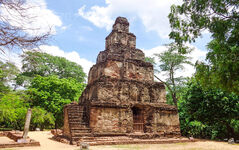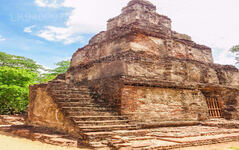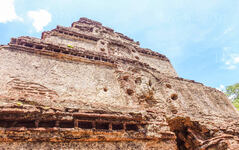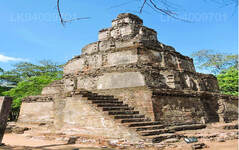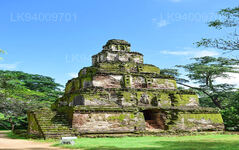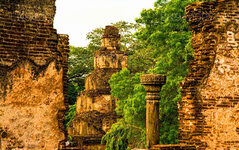
Polonnaruwa City
Polonnaruwa, a UNESCO World Heritage Site in Sri Lanka, was the country's medieval capital (11th-13th century). Renowned for its well-preserved ruins, including the iconic Gal Vihara statues, it showcases impressive architecture, reflecting the grandeur of the ancient Sinhalese civilization.
Sathmahal Prasada
Sathmahal Prasada in Sri Lanka: Die Stufenpyramide von Polonnaruwa
Sathmahal Prasada in Sri Lanka ist eine siebenstöckige Stufenpyramide, die sich auf einer Anhöhe inmitten der antiken Stadt Polonnaruwa befindet. Die Struktur verfügt über Eingänge auf allen vier Seiten und eine zusätzliche Treppe, um die oberen Ebenen zu erreichen. Es wird angenommen, dass es während der Polonnaruwa- Ära, etwa zwischen dem 11. und 13. Jahrhundert n. Chr., erbaut wurde. Es gibt jedoch keine Aufzeichnungen über diese Pyramide, ihren Erbauer oder Zweck.
Manche halten den siebenstöckigen Palast aufgrund seiner Nähe zu bedeutenden buddhistischen Ruinen wie Stupas, Klöstern usw. für einen Stupa. Allerdings ist die Architektur völlig anders und ähnelt keiner anderen antiken Architektur in Sri Lanka. Es ist die einzige Stufenpyramide in Sri Lanka und eines von nur vier anderen antiken Gebäuden mit quadratischer Grundfläche; die anderen sind allesamt beschädigte Stupas oder Klosterruinen in Anuradhapura. Es ist interessant festzustellen, dass keines der anderen drei Gebäude Anzeichen dafür aufweist, dass es sich um Pyramiden handelte, und dass alle von der Struktur her gedrungen zu sein scheinen.
Sathmahal Prasada in Sri Lanka: Ähnlichkeit mit Architekturen jenseits der Meere
Obwohl es in Sri Lanka selbst keine vergleichbare Architektur gibt, weist Sathmahal Prasada Ähnlichkeiten mit der Architektur einiger Kulturen jenseits der Ozeane auf.
• Stufenpyramiden sind Strukturen, die flache Plattformen oder „Stufen“ in einer vom Boden nach oben zurückgehenden Reihenfolge verwenden, um eine Form ähnlich einer geometrischen Pyramide zu bilden. Sie sind meist groß und bestehen aus mehreren Steinschichten.
• Im Laufe der Geschichte wurden in vielen Kulturen und Orten auf der ganzen Welt Stufenpyramiden gefunden.
• Interessanterweise gab es keine fest verankerten Verbindungen zwischen den verschiedenen Kulturen.
• Sathmahal Prasada ähnelt in seiner Struktur (mit Ausnahme der Treppe) am meisten dem Koh-Ker-Tempel und dem Baksei-Chamkrong-Tempel in Siem Reap, Kambodscha (beides sind Shiva-Tempel, die um das 10. Jahrhundert n. Chr. erbaut wurden) und ähnelt in kleinerem Maßstab dem Maya-Tempel Tempel der Masken in Tikal, Gautemala und einige andere Maya-Tempel.
About Polonnaruwa District
Polonnaruwa is the 2nd largest city in north central province in Sri Lanka. The ancient city of Polonnaruwa has been declared a World Heritage site by UNESCO Polonnaruwa has a great history of conquest and struggle behind it and rightfully forms the third element in the Cultural Triangle. Located about 140 kms north east from Kandy,Polonnaruwa offers hours of endless pleasure for history and culture lovers, as there are numerous sights of significance.
Much of the physical ruins standing today are credited to King Parakrama Bahu I who spent many royal resources on town planning, including parks, edifices, irrigation systems and so on. The period of his rule is considered a golden age where the kingdom thrived and prospered under a visionary ruler. The Parakrama Samudra is a mammoth tank and named after its patron. The popular kings Royal Palace, the Audience Hall encircled by beautifully carved stone elephants and the Bathing Pool reflect the superior engineering capabilities of the time.
About North Central Province
North Central Province which is the largest province in the country covered 16% of total country's land area. North Central Province consist two districts called Polonnaruwa and Anuradhapure. Anuradhapura is the largest district in Sri Lanka. Its area is 7,128 km².
North Central Province has numerous potentials for Investors to start their Businesses, especially Agriculture, agro based industries and Livestock sectors. More than 65% of North Central Province's people depend on basic Agriculture and agro base industries. NCP also called "Wew Bendi Rajje" because there are more than 3,000 medium and large scale tanks situated in the province. Sri maha bodiya, Ruwanweli seya, Thuparama dageba, Abayagiri Monastry, Polonnaruwa Rankot wehera, Lankathilake are scared

